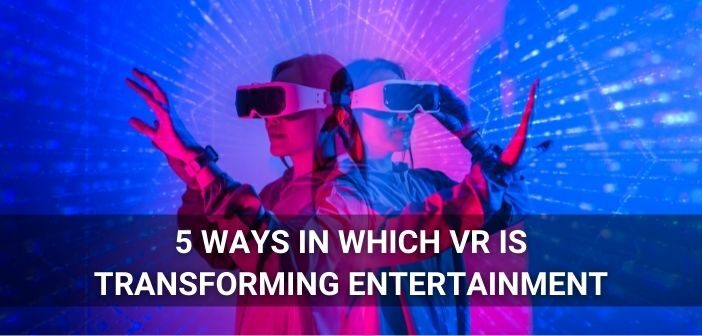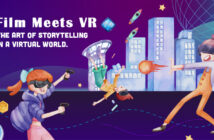A new era of entertainment for the masses is dawning with the evolution of Virtual Reality. The recent barrage of technological breakthroughs has aligned with a significant shift in pricing, finally matching the average consumer’s recreational budget.
With each new iteration of the technology, unprecedented experiences in film, gaming, art and even broadcasting have been made possible – and progressively more accessible. In tune, creators have taken the changes in stride and pioneered new, phenomenal ways to showcase the best of VR.
Here’s a look at five ways in which this is happening:
1. VR Movies and Documentaries
Cinema is the quintessential avenue of entertainment for modern urban life, a source of culture and public beat. For cinephiles, the quality of movie broadcasting is of the utmost importance; most movie-goers don’t back away from shelling big bucks to experience their favourite movies in HQ or even 3D.
 Image Courtesy: pressmaster from Adobe Stock
Image Courtesy: pressmaster from Adobe Stock
While footfall may have temporarily diminished in the last year, the next big change in cinema is already knocking on the public’s doorstep. The appreciating viability of the hardware is opening new grounds for the masses; the induction of Virtual Reality mediums in filmmaking will be nothing less than a total paradigm shift for the industry, with unparalleled sensory immersion and high empathy-generating experiences.
The immersive experience of VR will also breathe new life into the horror genre, and truly make for an experience of a lifetime. Horror has always been a tough nut to crack for movie writers, as it is not easy to scare people through a 2D screen. In fact, production houses are already using VR to create hype for horror movies such as IT (2017) by launching virtual reality trailers for marketing – and this shift will only scale with time from promotion to fully-fledged production.
2. Experiential Tech in VR
Entertainment is often associated with only dopamine-inducing activities, yet for many people, entertainment equals unique experiences. Travel, cultural events, or even just reading the news – storytelling, simply put, is the common thread through which we access experiences we may never have otherwise.
 Image Courtesy: undrey from Adobe Stock
Image Courtesy: undrey from Adobe Stock
Virtual Reality enables a sensorial interface through which we can access a simulated, enhanced, or alternative setting – all from the safety of our homes. Travel is often expensive, and may have adverse ecological effects – VR can change that entirely.
The Oculus headsets have been tapping into users’ latest wanderlust by providing many paid and unpaid VR travel experiences across some of the most untouched and challenging terrains of the planet. Even the Kumbh Mela, a major cultural gathering for Hindus, can be experienced through VR – helping devotees that couldn’t make it to the holy banks be a part of the event.
Beyond travel, VR can also enable unique experiences that cannot be commonly felt or described. Artist/Director Arnaud Colinart has created a unique VR experience called “Notes on Blindness” – a humbling foray into the process of losing one’s eyesight. Colinart uses the all-encompassing sensory input of virtual reality to make users live through far-sightedness and eventual blindness; with Virtual Reality, the idea of walking in someone else’s shoes to engender empathy is an actual possibility.
 Image Courtesy: Viacheslav Lakobchuk from Adobe Stock
Image Courtesy: Viacheslav Lakobchuk from Adobe Stock
3. VR Art
Our affinity and admiration for art is also set to transform with VR. Until now, most art has been 2D in nature – restricted either by the medium, or by the image-based documentation of the art piece. This renders 3D forms of art ineffective – especially traditional fixtures like sculptures and installations. As stationary objects, they cannot be observed and admired by an audience beyond their immediate vicinity.
Virtual Reality gives artists the ability to create art pieces entirely in 3D space, with no restrictions on their imagination. Google has started making strides in this space with the release of TiltBrush – a 3D art creation software powered by Unity and available on all major VR devices. VR is also enhancing the creation, viewing and evaluation of NFTs, which spells profit for independent and upcoming creators in the space.
Museums and art installations of the future will inevitably be available across the world using virtual reality. Many galleries and art collections have started to digitize their collections in this vein, such as the Van Gogh Collection.
 Image Courtesy: Gorodenkoff from Adobe Stock
Image Courtesy: Gorodenkoff from Adobe Stock
4. VR in Gaming
Any discussion about VR in entertainment is incomplete without gaming. An industry that is all about telling stories that players can live through, the virtual reality gaming industry has been valued at $18 billion USD in 2020 – and is predicted to grow at a breakneck 30% CAGR.
Games like BeatSaber have sold more than a million copies, and enjoy a wide audience. Even Skyrim, one of the world’s most bought PC games of all time has launched a VR version. A free-roam and interactive world that is known for its brilliant visuals, the combination of VR and fantastical scenarios results in addictive and never-ending gameplay.
Even cult classics like Star Wars have come out with a VR iteration of the saga, called the Vader Immortal – a playable episodic series. Even though the gaming experience isn’t worth writing home about, the unique combination of cinema and gaming makes the experience even more intense for fans who can now live in the world of their favourite characters.
 Image Courtesy: rh2010 from Adobe Stock
Image Courtesy: rh2010 from Adobe Stock
5. Virtual Reality in Sports
Sports are one of the oldest forms of collective entertainment – it follows that Virtual Reality will transform them as well. Die-hard sports fans often travel across the world to watch their favourite teams play; the live arena experience is surreal, and the shared atmosphere of excitement is a big pull for visitors across demographics.
However, stadium capacity, host-city infrastructure, and personal restrictions make the experience of watching one’s favourite team play live inaccessible to many. Virtual Reality streaming, made possible with the decreasing size of cameras and sensors, is quickly becoming popular amongst sports broadcasters.
In India, Hotstar has been breaking ground on bringing VR sports experiences to the country. Since 2017, they have covered multiple sports events, from the World Kabbadi Championship to the IPL. Viewers of these events have had the option to tune into 180-degree and 360-degree VR streams. The resultant feed provides realistic in-game viewership as if the user is present in the stadium.
 Image Courtesy: Elnur from Adobe Stock
Image Courtesy: Elnur from Adobe Stock
The application of virtual reality in entertainment is not breaking news, yet each new development in the field signals how much more can be achieved in the near future. The further scope and exploration of this technology has miles to go before we experience its zenith. As graphic processing and hardware quality get up to par with VR breakthroughs, virtual reality will become the main medium of entertainment across the board.




